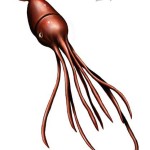The bubbles around me clear and as I regain my visibility my first thought is how wide is the mouth coming for me. Five feet? Six Feet? Will my whole body fit in there? As the whale shark closes the distance between us mouth first, I’m focused entirely on the size of the beast. It’s a big ‘un, bigger than 70’s big. Just feet shy of its intercept course, it casually slips below me into the ocean depths, emerging behind me unconcerned. Thankfully, I’m no Jonah and this is not my whale (or whale shark as the case may be). I know that the esophagus of a whale shark measures only inches across. The massive beast could not choke me down even if it preferred man meat to plankton. With this thought I relax, remembering I’m here off the Mexican coast snorkeling in the open ocean with no land in sight because I want to know exactly and precisely how big whale sharks actually get.
Why should I give a flying flip about how big they get?
Let’s just say it’s about more than bragging rights. Precise, accurate, and quantified measurements matter at both a philosophical and pragmatic level. Saying something is approximately “this big” while holding your arms out to indicate your full arm span just won’t cut it. This is science not a fishing story recounted over brews with the buds. And just like knowing whether you’re meeting your buds at 8 a.m. or 8 p.m. determines how you pace those brews, knowing the size limits of an organism makes a huge difference as well.
Given their size, both the whale shark and giant squid are surprisingly elusive. These behemoths lead predominantly solitary lives in the open, and often deep, oceans far from human sight. Finding a specimen to measure is like finding the proverbial needle in a haystack. So, why pursue it, right? Because this seemingly impossible task offers a huge payoff, duh.
From accurate measurements of size we can infer much about an organism. In some aspects this is basic physics. The mass of an object dictates friction, acceleration, force, and so on. The metabolism of an organism, telling us how much oxygen and carbon an animal consumes, is a function of size as well. Indeed, we have precise mathematical equations, based on studies of closely related species, that can tell what the metabolism of such giants would be. Knowing whether a whale shark is 10 tons, 15 tons, or 20 tons lets us know whether a whale shark uses 868, or 1176, or 1,460 light bulbs worth of energy every day. It doesn’t stop with metabolism either. In spite of errors and exceptions, heart rate, speed, growth, lifespan, population size, lifetime reproductive output, and many more things can all be estimated from body size. This provides a substantial advantage when trying to understand organisms we know virtually nothing about.
Changes in size over time can also tell us when a species, including our whale shark and squid, is in trouble. Researchers working on Nigaloo Reef off Australia found that the average length of whale sharks decreased by nearly two meters in the last decade. The most likely culprit is overfishing pressure the whale sharks encounter during other parts of their migration.
So, How big do Whale Sharks get?
Beer Google version: If you search around the internet you will find varying answers. This Whale Shark FAQ places the upper estimate of length at 21.4 meters (70.21 feet). A YouTube video claims that a filmed individual is 18.29 meters (60 feet). The conservation organization Oceana suggests the upper size is 20 meters (65.6 feet). Compare that to what you find in the scientific literature. Martin in 2007, “1 of only 10 sharks that routinely attain lengths of more than four metres [13.12 feet],” and Coleman ten years prior, “Most specimens reported in the literature are between 4 and 10 m [32.8 feet].”
The Sober Truth: According Coleman in 1997 the largest scientifically, i.e. accurately, measured whale shark was 12 meters (39.37 feet). Newer work on the Nigaloo Reef whale sharks also reports the maximum size at 12 meters. During my work with Al Dove on the estimating sizes of whale sharks at the Afeura (with lasers!), we found the maximum length to be 10 meters (32.8 feet). And although we’ve only measured just a few individuals so far, the length is far cry from the 20 meters so often reported. UPDATE: Simon Pierce commented below that it may be that one of the reasons we tend to measure smaller sharks in aggregations in coastal zones is that they are predominantly juveniles. He also notes that a “20 meter specimen was reported in the scientific literature from the Taiwan fishery in the 1990s and an 18.8 m specimen was reported from the Indian fishery (summarised by Rowat & Brooks 2012, JFB).”
What about the other big ‘un, the giant squid. How big do they get?
Beer Google Version: Getting a handle on how large another colossus of the ocean, the giant squid, can grow is equally vexing. In this video the reporter claims Giant Squids can reach 50 feet (15.24 meters). Marinebio.org claims that Giant Squids can reach 18 meters (~60 feet). Indeed the idea of a 60 foot Giant Squid appears to be part of the lore of the media (CBS, National Geographic, Discovery, Santa Cruz Sentinel to name just a few of many).
The Sober Truth: Does the 60-foot giant squid actually exist? No. As Steve O’Shea, giant squid expert, published at TOMNO,
“the largest specimen known washed ashore on a New Zealand beach, Lyall Bay (Wellington) in the winter of 1887. It was a female and “in all ways smaller than any of the hitherto-described New Zealand species”, according to Kirk (1887), the gentleman who described this very specimen. Apparently it measured 55 feet 2 inches in total length (16.8m), but this simply cannot be correct, and this length almost certainly is a product of imagination or lengthening (stretching like rubber bands) of the very slight tentacular arms, as it mantle was only 71 inches long (1.8m). We know that it was not measured with a conventional tape, but was paced, as Kirk says so in his publication. A comparable-sized female (ML 1.8m) measured post mortem and relaxed (by modern standards) today would have a total length of ~32 feet (9.8m)…Of more than 130 Architeuthis specimens that the authors have examined, none has attained total length [exceeding] of 13m (42 feet). “
For my own work, I have compiled every known scientific measurement of a giant squid (these don’t include Steve’s unpublished data). Below is a plot of how many individuals of different sizes are known to date. The three largest washed ashore in Spain in 2003 are 36.4, 39.1, and 39.4 feet long (11.1, 11.97, and 11.99 meters). However, as Steve mentions most giant squids rarely reach this size. Most are between 10 and 30 feet almost half of the super giant squid purported at 60 feet.

http://dx.doi.org/10.6084/m9.figshare.156047
Retrieved 15:08, Feb 07, 2013 (GMT). Please used the preceding citation for figure use.
Why do we make a “big fish” out of everything?
Frankly, humans are crap at eyeballing size. We suffer from what is called size constancy. Psychologist Irene Sperandio explains it like this:
Humans also have the tendency to tell distorted stories either for simplicity or just plain good entertainment value. In one study, participants labeled 61% of their retellings as distorted (containing exaggerations, omissions, minimizations, or additions) and 42% of their retellings as completely inaccurate (pdf is here and gives a great overview of this area of research). The accuracy and recall of details gets even worse if we are telling a story for entertainment as opposed to accuracy. Of course, accuracy can be altered by who the audience is and how attentive they are and by the accounts of other eyewitnesses.
Humans also seem to focus on extremes. Stephen Jay Gould acknowledged this tendency when he slammed the idea of Cope’s Rule (that size of animals increases through the fossil record and through time).
“Our strong and biased predilection for focusing on extremes (and misconstruing their trends as surrogates for a totality), rather than documenting full ranges of variation, generates all manner of deep and stubborn errors…We should remember Little Buttercup’s admonition to Captain Corcoran in H.M.S Pinafore, that ‘things are seldom what they seem,’ while we must shun the allure of bigness, for ‘bulls are but inflated frogs’.”
In short (pun intended), size does matter. And, whale sharks and giant squids are large enough without humans helping them along.







Hi Dr M! Great article. Just wanted to add in some additional info on whale sharks.
A big part of the reason why there’s so much confusion around their upper size is the predominance towards juvenile (and usually male) sharks in almost every coastal aggregation known around the world, including Ningaloo Reef (Meekan et al. 2006, MEPS; Norman & Stevens 2007, Fish Res) and off Mexico (Ramirez et al. 2012, JFB).
The 12 m shark was a stranded specimen measured with a tape measure, by a scientist, and remains the largest physically measured by a scientist to my knowledge. However, a 20 m specimen was reported in the scientific literature from the Taiwan fishery in the 1990s and an 18.8 m specimen was reported from the Indian fishery (summarised by Rowat & Brooks 2012, JFB).
There are predictable sightings of thumping big live ones in the Eastern Pacific every year. This area is the only place where the genuinely enormous 15 m+ females are regularly seen by divers. Two of the sharks tagged by Eckert and Stewart (2001, Env Biol. Fish) off Mexico were visually estimated at 15 and 18 m apiece.
Though not much is known about the size of female maturity (the smallest, and only, pregnant female was 10.6 m), male maturity appears to vary between around 7.5-9 m through their distribution, suggesting that there probably isn’t huge variation in maximum size throughout the world. The big sharks are out there somewhere – they’re just not often being seen!
Thanks for this. The phenomenon of poor size estimation arises all the time with rattlesnakes (http://www.livingalongsidewildlife.com/2009/07/return-of-giant-killed-rattlesnake.html). I may borrow the resources and animations you use above to tackle this unusually persistent myth.